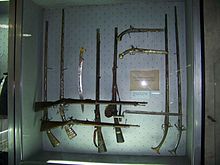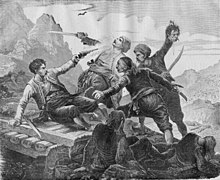Herzegovina uprising (1875–1877)
You can help expand this article with text translated from the corresponding article in Serbian. (January 2012) Click [show] for important translation instructions.
|
| Herzegovina Uprising of 1875 | |||||||
|---|---|---|---|---|---|---|---|
 An illustrated depiction of Bogdan Zimonjić, Mićo Ljubibratić, Stojan Kovačević and Pecija in the 1876 issue of Orao, a Serb annual magazine published in Novi Sad | |||||||
| |||||||
| Belligerents | |||||||
|
| ||||||
| Commanders and leaders | |||||||
|
| ||||||
| Strength | |||||||
| 24,000+ | |||||||
The Herzegovina uprising (
The uprising was precipitated by the harsh treatment under the
The rebels were aided with weapons and volunteers from the principalities of
Background
In the early 19th century, most of the Balkans was under Ottoman rule. Christian communities of Serbs and Greeks, under Ottoman control for four centuries, rose up and succeeded in obtaining autonomy by means of the
The
Other notable preceding Serb peasant rebellions in the region were the
Preparations

In Herzegovina
The Serbian leaders of the people of Herzegovina:
The Ottomans heard of the talks between Nikola I and tried to capture the ringleaders, who fled into Montenegro in the winter of 1874. In 1875, Austria was drawn in, who with its interests in Bosnia and Herzegovina, asked the Ottomans to give the ringleaders amnesty. The Ottomans agreed to enter discussions with Austria.
In Bosnia
The preparations started somewhat later than the Herzegovinian and did not manage to coordinate actions of the two regions. In the preparations are
Uprising in Herzegovina

Gabela
The Catholic
Nevesinje


The leaders returned in 1875 and continued their plans for revolt, the plan was for the liberation of Nevesinje region, then expansion to the rest of Herzegovina. In the meantime, Turks seek hajduk Pera Tunguz, who on 5 July, had attacked a caravan on Bišini mountain. On 9 July, the Turks clashed with the armed villagers of Jovan Gutić on the Gradac hill north of Krekovi. This conflict would be known in Serbian as Nevesinjska puška ("Nevesinje rifle") and marked the beginning of the uprising in all of Herzegovina. Firstly Nevesinje, Bileća and Stolac were involved, then in August, Gacko and the frontier towards Montenegro. Bands (known as četa) of 50–300 people and detachments of 500–2,000 people gathered and attacked Ottoman border posts and bey towers.
The Ottomans had 4 battalions of the regular army (Nizami) with a total of 1,800 soldiers, situated in
Prince Nikola sent Petar Vukotić, while a large number of Montenegrin volunteers arrived at the command of Peko Pavlović. The Serbian government dared not to publicly assist because of international pressure but secretly sent Mićo Ljubibratić (who took part in the 1852–1862 uprising) among others. There was a conflict between the rebels because of disagreement between the representatives of the Montenegrin and Serbian governments, causing failures in the ongoing uprising.

Many Europeans took part in the uprising with the idea of bringing down Muslim rule over Christians (mainly Italians, former Garibaldinians).[12]
Uprising in Bosnia

According to Herr Fritz, the Serb rebels were "extremely numerous and in some cases well armed" and were divided among following troops and bands:[13]
- Risovac and Grmeč, in West Bosnia, under the leadership of well-known Golub Babić, Marinković, Simo Davidović, Pop-Karan and Trifko Amelić. The Serbian colonel Mileta Despotović held supreme leadership and had formed 8 battalions out of the scattered bands.
- Vučjak, in East Bosnia.
- Novi, was held by Ostoja Vojnović. The former camp of Karađorđevići in Ćorkovacwas held by Ilija Sević.
The aim of the Bosnian rebel bands was to prevent any greater concentration of Ottoman troops on the
According to Mackenzie and Irby who travelled the region in 1877, the state of the common Christian people was serious, and the number of fugitives exceeded 200,000 all round the frontier by January 1877.[15]
The rebels in South Bosnia had cleared the region of Muslims, presently under the command of Despotović, between the Austrian frontier and the Ottoman fortresses of Kulen Vakuf, Ključ and Glamoč.[16]
In August 1877, all Bosnian Muslims men from 15 to 70 were ordered to fight, although there was already 54 battalions, each with 400–700 men.[17]
Aftermath

The uprising was the starting point of the
Legacy
History of Herzegovina |
|---|
|
|
|
The Nevesinje municipality has a coat of arms with two rifles, symbolising the revolt. The government of Republika Srpska together with the Nevesinje municipality annually organises the anniversary of the revolt.[19]
In 1963, a Yugoslav film by Žika Mitrović about the Nevesinje rebellion was released, titled in Serbian as Невесињска пушка and in English as Thundering Mountains.[20]
Jovan Bratić (born 1974), a comic artist from Nevesinje, made a cartoon series on the Herzegovina Uprising, titled Nevesinjska puška, the first part released in 2008,[21] and the second part Nevesinjska puška 2: Bitka na Vučjem dolu.[22]
According to historian Edin Radušić "Milorad Ekmečić gave the main word in interpretations of a wide range of issues related to the uprising in domestic historiography, in the 1960s he from Vaso Čubrilović took over the primacy as the main interpreter of the uprising, and since then he had the greatest influence on other historians who have dealt with this thematic framework". Also, "Ekmečić became more openly politically engaged in recent works, openly linking the motives of the 19th century uprising with the insurgent movements from WWII and violence in Bosnia and Herzegovina from the end of the 20th century, with the thesis of religious war as the appearance of the long duration, which has one of its key episodes in the uprising of 1875–1878".[23]
See also
References
- ^ Ćirković 2004, pp. 221–226.
- ^ a b c d Stojanović 1968, p. 2.
- ^ a b c d Reid 2000, p. 309.
- ISBN 0230354319
- ISBN 978-9958992407
- ^ Miloš Ković; (2010) The Beginning of the 1875 Serbian Uprising in Herzegovina The British Perspective pp. 60–61; Balcanica XLI, Belgrade, [1]
- ISBN 978-9958992407
- ^ Miloš Ković; (2010) The Beginning of the 1875 Serbian Uprising in Herzegovina The British Perspective pp. 60–61; Balcanica XLI, Belgrade, [2]
- ISBN 9536045036
- ^ Ćirković 2004, p. 223.
- ISBN 1610690303
- .
- ^ Mackenzie & Irby 2010, p. 42.
- ^ Mackenzie & Irby 2010, p. 43.
- ^ Mackenzie & Irby 2010, p. 47.
- ^ Mackenzie & Irby 2010, p. 50.
- ^ Milojković-Djurić 1994.
- ^ Stojanović 1968, p. 11.
- ^ "Obilježeno 137 godina od ustanka "Nevesinjska puška"". Alternativna TV (in Serbian). 8 July 2012.
- ^ "Thundering Mountains (1963)". IMDb.
- ^ "U prodaji je drugo objedinjeno izdanje stripa 'Nevesinjska puška'" (in Bosnian). Moja Hercegovina. 17 April 2013. Archived from the original on 22 February 2014.
- ^ "Intervju sa Jovanom Bratićem strip autorom iz Nevesinja". 30 October 2012. Archived from the original on 22 February 2014.
- ^ Edin Radušić; (2020) Pitanje ustanka 1875–1878. u bosanskohercegovačkoj historiografiji: između historijske istine i multiperspektivnosti (The question of the uprising of 1875–1878. in Bosnia and Herzegovina historiography: between historical truth and multiperspectivity) pp. 104–105; ANUBiH CLXXXVII [3]
Sources
- ISBN 978-2911527104.
- ISBN 978-2825119587.
- Bogićević, Vojislav (1950). Stanje raje u Bosni i Hercegovini pred ustanak 1875–1878 godine: povodom 75-godišnjice ustanka u Hercegovini i bosanskoj krajini 1875–1878. Državna štamparija u Sarajevu.
- ISBN 978-1405142915.
- Čubrilović, Vasa; Antonić, Zdravko (1996). Bosanski ustanak 1875–1878 [Bosnian Uprising 1875–1878]. Službeni list SRJ. ISBN 978-8635502885.
- Ekmečić, Milorad (1973). Ustanak u Bosni 1875–1878 [Uprising in Bosnia 1875–1878]. Sarajevo: Veselin Masleša.
- Gutić, Vasilije M. (1980). Opšta i diplomatska istorija ustanka u Hercegovini i Bosni iz 1875–1878. godine. V. Gutić.
- Harris, David (1928). Balkan diplomacy, July, 1875 to July, 1876: from the revolt in Herzegovina to the Reichstadt agreement ... Leland Stanford Junior University.
- Jagodić, Miloš (2004). Насељавање Кнежевине Србије : 1861–1880. Istorijski institut. ISBN 978-8677430467.
- Ković, Miloš (2010). "The beginning of the 1875 Serbian uprising in Herzegovina: the British perspective". Balcanica (41): 55–71. .
- ISBN 978-1616404055.
- Milojković-Djurić, Jelena (1994). Panslavism and national identity in Russia and in the Balkans, 1830–1880: images of the self and others. East European Monographs. ISBN 978-0880332910.
- Никифоров, Д.И. (2015). Петр Карагеоргиевич в Боснийском восстании 1875–1878 годов.. Новая и новейшая история (in Russian). 2: 183–191.
- Radoičić, Mirko S. (1966). Hercegovina i Crna Gora 1875–1878 (in Serbo-Croatian). Savez udruženja boraca NOR-a, Opštinski odbor.
- Reid, James J. (2000). Crisis of the Ottoman Empire: Prelude to Collapse 1839–1878. Franz Steiner Verlag. ISBN 978-3515076876.
- Rupp, George Hoover (1941). A Wavering Friendship: Russia and Austria, 1876–1878. Harvard University Press.
- Stojanović, Mihailo D. (1968) [1939]. The Great Powers and the Balkans, 1875–1878. Cambridge University Press.
- Šipovac, T. (1979). Nevesinjska puška. Beograd.
{{cite book}}: CS1 maint: location missing publisher (link) - Ustanak u Bosni od 1875. do 1878. god: građa za noviju srpsku istoriju rata za oslobođenje. Pajević. 1884.
- Vojna Enciklopedija. Vol. 1. Beograd. pp. 756–759.
External links
- "У организацији Одбора за његовање традиција ослободилачких ратова Владе Републике Српске: Обиљежена 134. годишњица Невесињске пушке". Frontal. Archived from the original on 26 March 2012.
